Evaluation on the Current Situation of Integrated Treatment of Rural Sewage in China: A Case Study of Anhui Province
Abstract
1. Introduction
- (1)
- Rural drinking water quality. Cotruvo, J.A., 2017 introduced the current world drinking water pollution situation [3]. Using the GIS-MCDA method, Silva, M.C.O. et al., 2022 discussed the risk of a water supply and sanitary sewage system in a city in Brazil’s semi-arid region [4]. Alver, A., 2019 discussed the efficiency evaluation of conventional drinking water treatment plants using the water quality index and health risk index [5]. Čeli, Ć.M. et al., 2020 assessed the occurrence and environmental risks of interfering compounds in drinking water, surface water and wastewater in Serbia [6]. Taking rural areas of Luzhou City as an example, Ji R. et al., 2018 introduced the unsanitary situation of rural drinking water in China and the endemic diseases caused by it and put forward policy suggestions for improving the water environment [7].
- (2)
- The experience of developed countries in improving rural water pollution and suggestions for rural sewage treatment in developing countries. Awad, H. et al., 2019 conducted an environmental and cost life cycle assessment on improving wastewater treatment in developing countries [8]. Liu, Y. et al., 2018 introduced the experience of rural domestic sewage treatment in the United States, Japan, Germany, Sweden and other developed countries [9]. Ziembawic, S. et al., 2021 studied the impact of landfill leachate on rural water pollution [10]. From the perspective of excessive chemical fertilizers and pesticides in agricultural production and nonstandard treatment of livestock and poultry manure in aquaculture, Chen, X.M. et al., 2016 analyzed the root causes of rural water pollution in China and put forward relevant policy recommendations to mitigate this pollution [11].
- (3)
- Technical discussion on rural sewage treatment, especially the use of extracts from agricultural and sideline products to implement low-cost treatment of sewage by simple methods. Diab, K.E. et al., 2021 introduced that the use of biocompatible MIP-202 Zr MOF tunable adsorbent can effectively purify the electro ion pollution in waste liquid [12]. Mohamed, S. et al., 2017 systematically introduced the technology of extracting low-cost adsorbent from agricultural and sideline products to enhance the absorption of pollutants in wastewater [13]. Marius, G.M. et al., 2021 studied the problem of sewage sludge treatment with materials activated by a low amount of alkaline hydroxide [14]. Saravanan, A. et al., 2021 gave a comprehensive introduction to the effective methods of removing toxic pollutants from wastewater that can work continuously for a long time [15]. Singh, S. et al., 2020 introduced the method of using low-cost adsorbent to remove inorganic impurities from wastewater [16]. There are many similar studies, for example, Salerno, F. et al., 2018 [17].
- (4)
- Assessment of the pollution of rivers, lakes and groundwater using mathematical models. Ashfaq, M. et al., 2019 studied the seasonal variation and risk assessment of pollutants in the Jiulong River and its estuary in China [18]. Triassi, M. et al., 2022 discussed the temporal and spatial distribution of pollutants in the aquatic environment of the Volturo River estuary in southern Italy [19]. El Osta, M. et al., 2022 discussed the suitability of groundwater drinking and irrigation in Al Mukarramah Province, Makkah, Saudi Arabia, using the water quality index and multivariate modeling [20]. Gad, M. et al., 2021, 2022 assessed the surface water quality of Qaroun Lake in Egypt and the Nile River, respectively, by using the comprehensive water quality index and multivariate modeling [21]. There are many similar studies (see [22,23,24,25]). Norouzi, H. et al., 2020 used the aquifer in the Miandoab plain in northwest Iran as a case to discuss the groundwater quality assessment by using the random forest method [26]. Pennino, M.J. et al., 2020 discussed the pattern and prediction of nitrate violations in drinking water across the United States [27]. Ratolojanahary, R. et al., 2019 established groundwater quality assessment models under the background of supervisory and non-supervisory mechanisms [28]. Shah, M.I. et al., 2021 studied the prediction of surface water quality based on the machine learning model of super parameter optimization with consistent big data [29].
2. Overview of Rural Economic Environment and Water Environment Treatment in Anhui Province
3. Materials and Methods
3.1. Methodology
3.1.1. Determine the Weight of Evaluation Indicators
- (i)
- Establish an expert group composed of m people, let each expert compare the importance of indicators in pairs, and construct a positive reciprocal judgment matrix. Let the matrix constructed by the k-th judge be as follows:where indicates that the k-th expert considers the degree of importance of indicator relative to indicator . Noting .
- (ii)
- Calculate the maximum characteristic value of , and check the consistency of . Calculate the value of index , where , and is given in Table 2 below.
- (iii)
- The characteristic vector of matrix corresponding to the is calculated with a simple method, where . By uniting the vector , we can obtain .
- (i)
- Unitize vector That is, for the i-th index, calculate the proportion of the index value of the j-th participating unit
- (ii)
- Calculate the entropy of the indicator
- (iii)
- Calculate difference coefficient of indicator
- (iv)
- The weights of each indicator can be obtained by normalizing the coefficient of difference: .
3.1.2. Fuzzy Comprehensive Evaluation Method
3.1.3. Grey Correlation Coefficient and Correlation Degree
3.2. Data Collection and Sorting
3.2.1. Data Collection
- (i)
- Overall situation of rural sewage treatment
- (ii)
- Disparities in sewage treatment in different regions with different economic development levels
- (iii)
- Quantitative data
3.2.2. Data Sorting
3.3. Assessment of Rural Water Environment Pollution and Treatment
3.3.1. Progress Evaluation of Comprehensive Treatment of Rural Sewage
3.3.2. Comprehensive Evaluation of Rural Water Environment Pollution
3.3.3. Correlation between Sewage Treatment Progress and Regional Economy
3.3.4. Evaluation of Operation Status of Rural Sewage Treatment Facilities
3.4. Results and Discussion
4. Summary
Author Contributions
Funding
Data Availability Statement
Conflicts of Interest
References
- Du, J.; Jin, H.W.; Chen, L.D. Development status and trend analysis of livestock and poultry waste resource utilization equipment industry. Chin. Cows 2019, 11, 47–50. [Google Scholar]
- Wang, M.G.; Yang, H.Q. Dilemma analysis and legal countermeasures of rural domestic waste disposal. Manag. J. 2020, 1, 100–101. [Google Scholar]
- Cotruvo, J.A. WHO guidelines for drinking water quality: Frst addendum to the fourth edition. J.-Am. Water Work. Assoc. 2017, 109, 2–39. [Google Scholar]
- Silva, M.C.O.; Vasconcelos, R.S.; Cirilo, J.A. Risk mapping of water supply and sanitary sewage systems in a city in the Brazilian Semi-Arid Region using GIS-MCDA. Water 2022, 14, 3251. [Google Scholar] [CrossRef]
- Alver, A. Evaluation of conventional drinking water treatment plant efficiency according to water quality index and health risk assessment. Environ. Sci. Pollut. Control Ser. 2019, 26, 27225–27238. [Google Scholar] [CrossRef]
- Čelić, M.; Škrbić, B.D.; Insa, S.; Živančev, J.; Gros, M.; Petrović, M. Occurrence and assessment of environmental risks of endocrine disrupting compounds in drinking, surface and wastewaters in Serbia. Environ. Pollut. 2020, 262, 114344. [Google Scholar] [CrossRef]
- Ji, R.; Zou, Y.F.; Dong, W.T.; Yang, M.R.; Zhang, Q.; Zhang, X.Q. Investigation on the pollution of untreated drinking water and common diseases in rural areas of Naxi District, Luzhou city. Green Technol. 2018, 18, 54–58. [Google Scholar]
- Awad, H.; Gar Alalm, M.; El-Etriby, H.K. Environmental and cost life cycle assessment of different alternatives for improvement of wastewater treatment plants in developing countries. Sci. Total Environ. 2019, 660, 57–68. [Google Scholar] [CrossRef]
- Liu, Y. Management measures and Enlightenment of municipal sewage treatment in Sweden. Environ. Pollut. Prev. 2016, 38, 81–85. [Google Scholar]
- Ziembowicz, S.; Kida, M.; Koszelnik, P.; Czarnota, J.; Miąsik, M. Fenton-like degradation of di-n-butyl phthalate in landfill leachate by endogenous catalysts or iron, copper and manganese loaded bottom sediments. Environ. Nanotechnol. Monit. Manag. 2021, 16, 100551. [Google Scholar] [CrossRef]
- Chen, X.M.; Wang, C.L.; Bo, R. Current Situation of Pesticide Use in China and Countermeasures. Pestic. Sci. Manag. 2016, 37, 4–8. [Google Scholar]
- Diab, K.E.; Salama, E.; Hassan, H.S.; El-moneim, A.; Elkady, M.F. Biocompatible MIP-202 Zr-MOF tunable sorbent for cost-effective decontamination of anionic and cationic pollutants from waste solutions. Sci. Rep. 2021, 11, 1–13. [Google Scholar] [CrossRef] [PubMed]
- Mohamed, S.; Jacek, N.; Andrzej, G. Low-cost Adsorbents Derived from Agricultural By-products/Wastes for Enhancing Contaminant Uptakes from Wastewater: A Review. Pol. J. Environ. Stud. 2017, 26, 479–510. [Google Scholar]
- Marius, G.M.; Anca, Z.; Simona, O.; Bucura, F.; Raboaca, M.S.; Filote, C.; Ionete, R.E.; Niculescu, V.C.; Constantinescu, M. Sewage Sludge Derived Materials for CO2 Adsorption. Appl. Sci. 2021, 11, 7139. [Google Scholar] [CrossRef]
- Saravanan, A.; Senthil, K.P.; Jeevanantham, S.; Karishma, S.; Tajsabreen, B.; Yaashikaa, P.R.; Reshma, B. Effective water/wastewater treatment methodologies for toxic pollutants removal: Processes and applications towards sustainable development. Chemosphere 2021, 280, 130595. [Google Scholar] [CrossRef]
- Singh, S.; Wasewar, K.L.; Kansal, S.K. Low-cost adsorbents for removal of inorganic impurities from wastewater. In Inorganic Pollutants in Water; Elsevier: Amsterdam, The Netherlands, 2020; Chapter 10; pp. 173–203. [Google Scholar]
- Salerno, F.; Gaetano, V.; Gianni, T. Urbanization and climate change impacts on surface water quality: Enhancing the resilience by reducing impervious surfaces. Water Res. 2018, 144, 491–502. [Google Scholar] [CrossRef]
- Ashfaq, M.; Sun, Q.; Ma, C.; Rashid, A.; Li, Y.; Mulla, S.I.; Yu, C.P. Occurrence, seasonal variation and risk evaluation of selected endocrine disrupting compounds and their transformation products in Jiulong river and estuary, China. Mar. Pollut. Bull. 2019, 145, 370–376. [Google Scholar] [CrossRef]
- Triassi, M.; Montuori, P.; Provvisiero, D.P.; De Rosa, E.; Di Duca, F.; Sarnacchiaro, P.; Díez, S. Occurrence and spatial-temporal distribution of atrazine and its metabolites in the aquatic environment of the Volturno River estuary, southern Italy. Sci. Total Environ. 2022, 803, 149972. [Google Scholar] [CrossRef]
- El Osta, M.; Masoud, M.; Alqarawy, A.; Elsayed, S.; Gad, M. Groundwater suitability for drinking and irrigation using water quality indices and multivariate modeling in makkah Al-Mukarramah province, Saudi Arabia. Water 2022, 14, 483. [Google Scholar] [CrossRef]
- Gad, M.; Abou El-Safa, M.M.; Farouk, M.; Hussein, H.; Alnemari, A.M.; Elsayed, S.; Khalifa, M.M.; Moghanm, F.S.; Eid, E.M.; Saleh, A.H. Integration of water quality indices and multivariate modeling for assessing surface water quality in Qaroun lake, Egypt. Water 2021, 13, 2258. [Google Scholar] [CrossRef]
- Jabbar, F.K.; Grote, K. Statistical assessment of nonpoint source pollution in agricultural watersheds in the Lower Grand River watershed, MO, USA. Environ. Sci. Pollut. Control Ser. 2019, 26, 1487–1506. [Google Scholar] [CrossRef]
- Khan, R.; Jhariya, D.C. Groundwater quality assessment for drinking purpose in Raipur city, Chhattisgarh using water quality index and geographic information system. J. Geol. Soc. India. 2017, 90, 69–76. [Google Scholar] [CrossRef]
- Nong, X.Z.; Shao, D.G.; Zhong, H.; Liang, J.K. Evaluation of water quality in the South-to-North Water Diversion Project of China using the water quality index (WQI) method. Water Res. 2020, 178, 115781. [Google Scholar] [CrossRef]
- Marín Celestino, A.E.; Martínez Cruz, D.A.; Otazo Sánchez, E.M.; Gavi Reyes, F.; Vásquez Soto, D. Groundwater quality assessment: An improved approach to K-means clustering, principal component analysis and spatial analysis: A case study. Water 2018, 10, 437. [Google Scholar] [CrossRef]
- Norouzi, H.; Moghaddam, A.A. Groundwater quality assessment using random forest method based on groundwater quality indices (case study: Miandoab plain aquifer, NW of Iran). Arabian J. Geosci. 2020, 13, 912. [Google Scholar] [CrossRef]
- Pennino, M.J.; Leibowitz, S.G.; Compton, J.E.; Hill, R.A.; Sado, R.D. Patterns and predictions of drinking water nitrate violations across the conterminous United States. Sci. Total Environ. 2020, 722, 137661. [Google Scholar] [CrossRef]
- Ratolojanahary, R.; Hou´e, N.R.; Medjaher, K.; Dauriac, F.; Sebilo, M. Groundwater quality assessment combining supervised and unsupervised methods. IFAC Pap. Online 2019, 52, 340–345. [Google Scholar] [CrossRef]
- Shah, M.I.; Javed, M.F.; Alqahtani, A.; Aldrees, A. Environmental assessment-based surface water quality prediction using hyper-parameter optimized machine learning models based on consistent big data. Process Saf. Environ. Protect. 2021, 151, 324–340. [Google Scholar] [CrossRef]
- Xu, W.; Sun, T. Risk assessment and analysis of harmful residues in edible agricultural products in China: Take Anhui Province as an example. Environ. Sci. Pollut. Res. 2021, 28, 54317–54338. [Google Scholar] [CrossRef]
- Xu, W.; Xu, F.; Liu, Y.Z.; Zhang, D. Assessment of Rural Ecological Environment Development in China’s Moderately Developed Areas: A Case Study of Xinxiang, Henan Province. Environ. Monit. Assess. 2021, 193, 1–25. [Google Scholar] [CrossRef] [PubMed]
- Deng, J.L. Basic Method of Grey System; Huazhong University of Technology Press: Wuhan, China, 1987; pp. 19–41. [Google Scholar]
- Xia, J.; Zuo, Q.T. 40 Years of Water Resources Utilization and Protection in China (1978–2018). Urban Environ. Res. 2018, 6, 1850022. [Google Scholar]
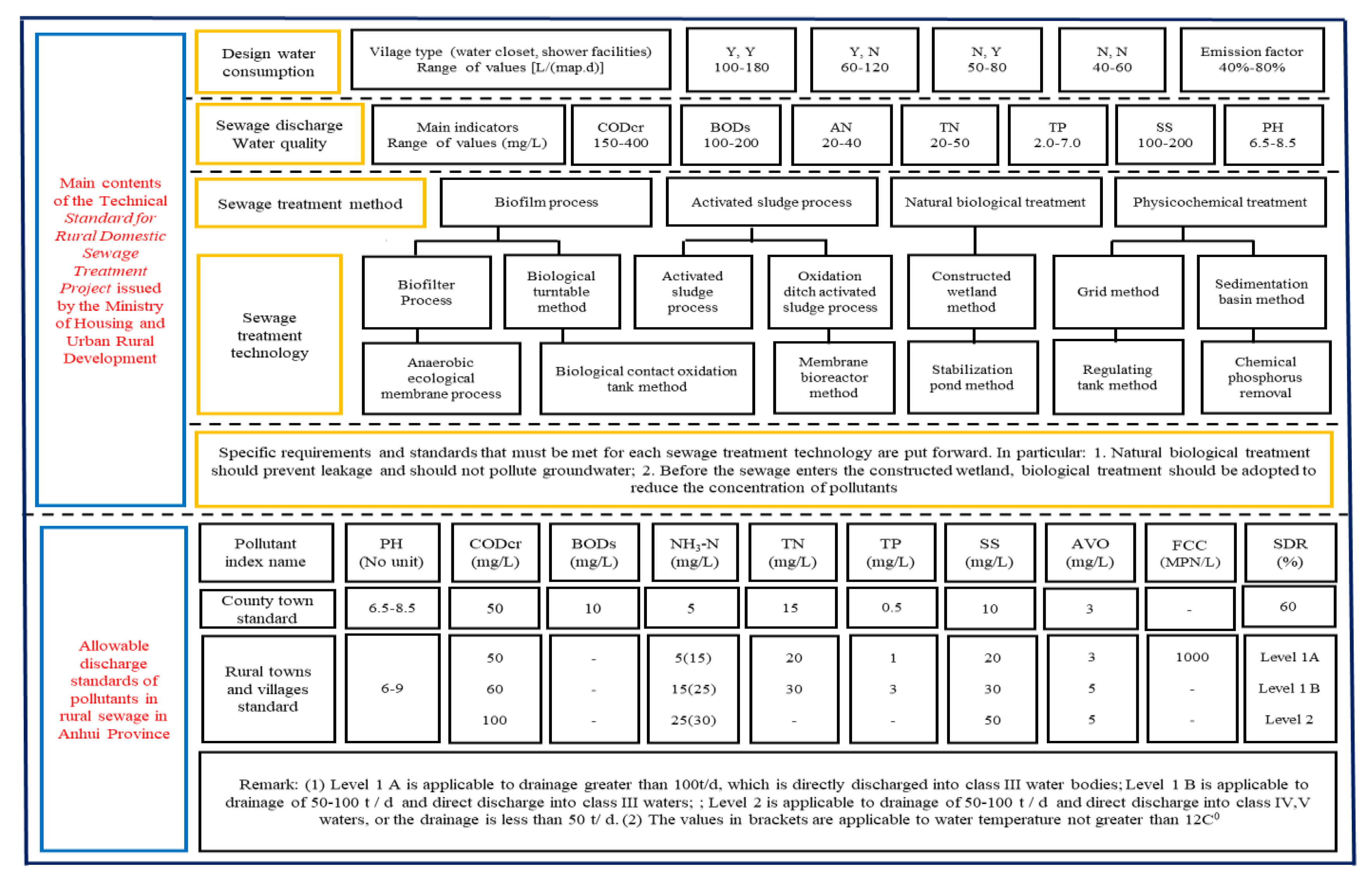

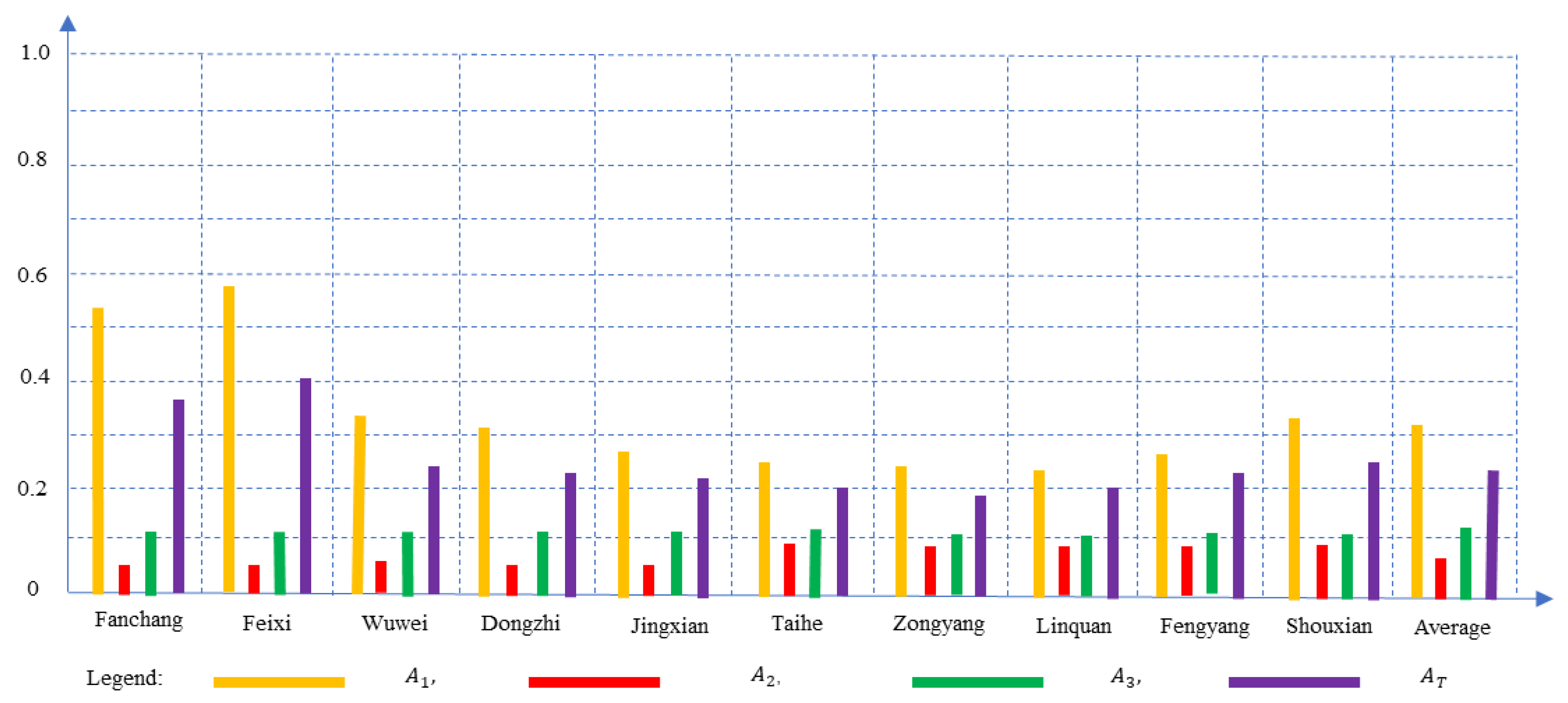
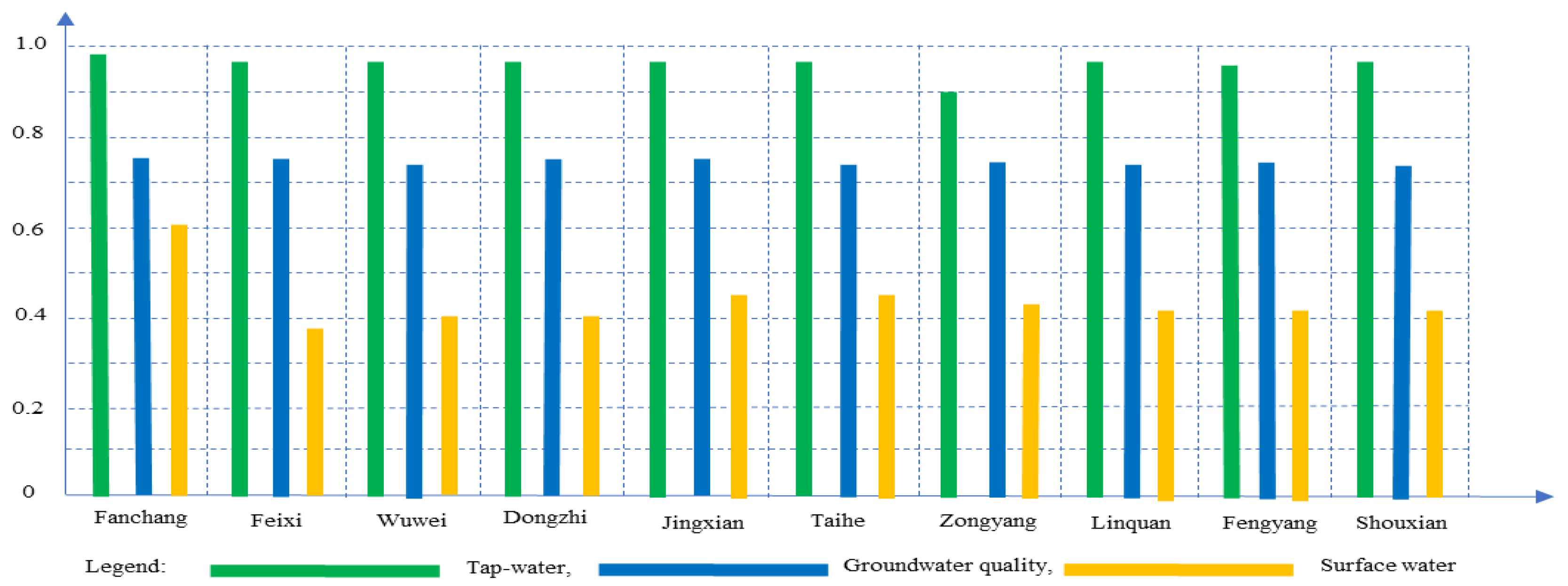
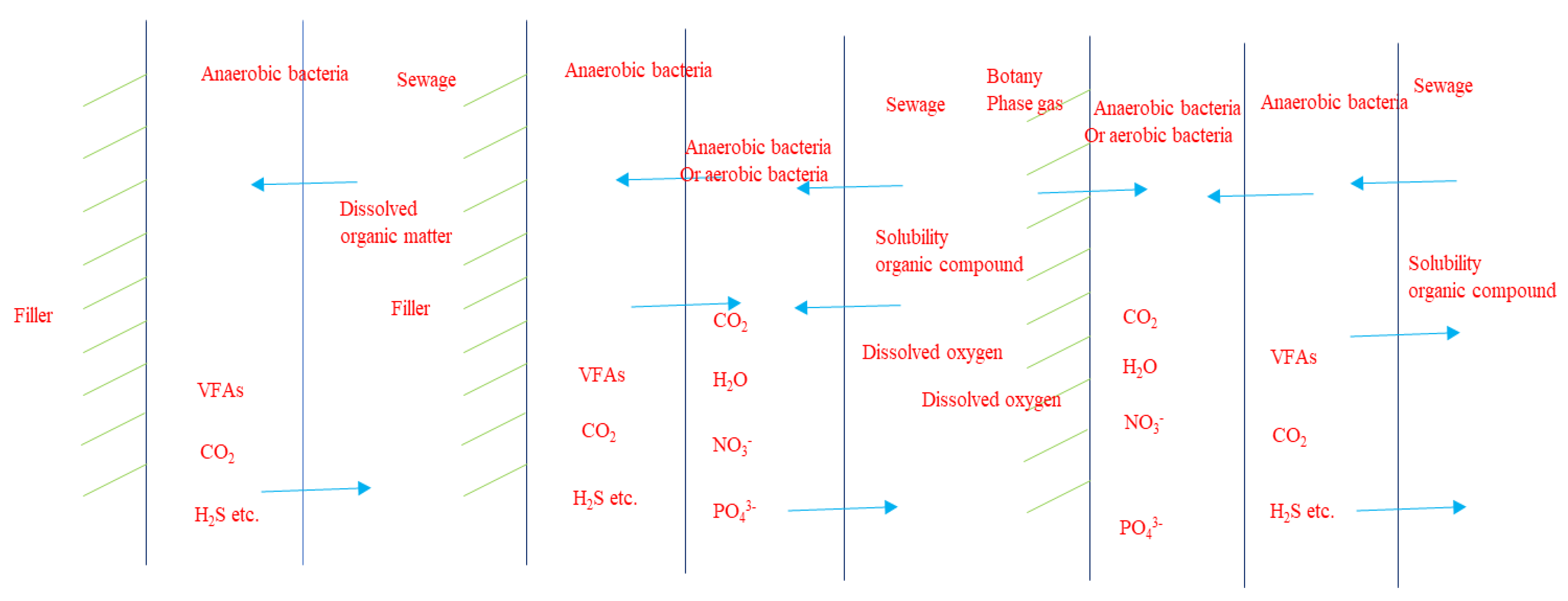
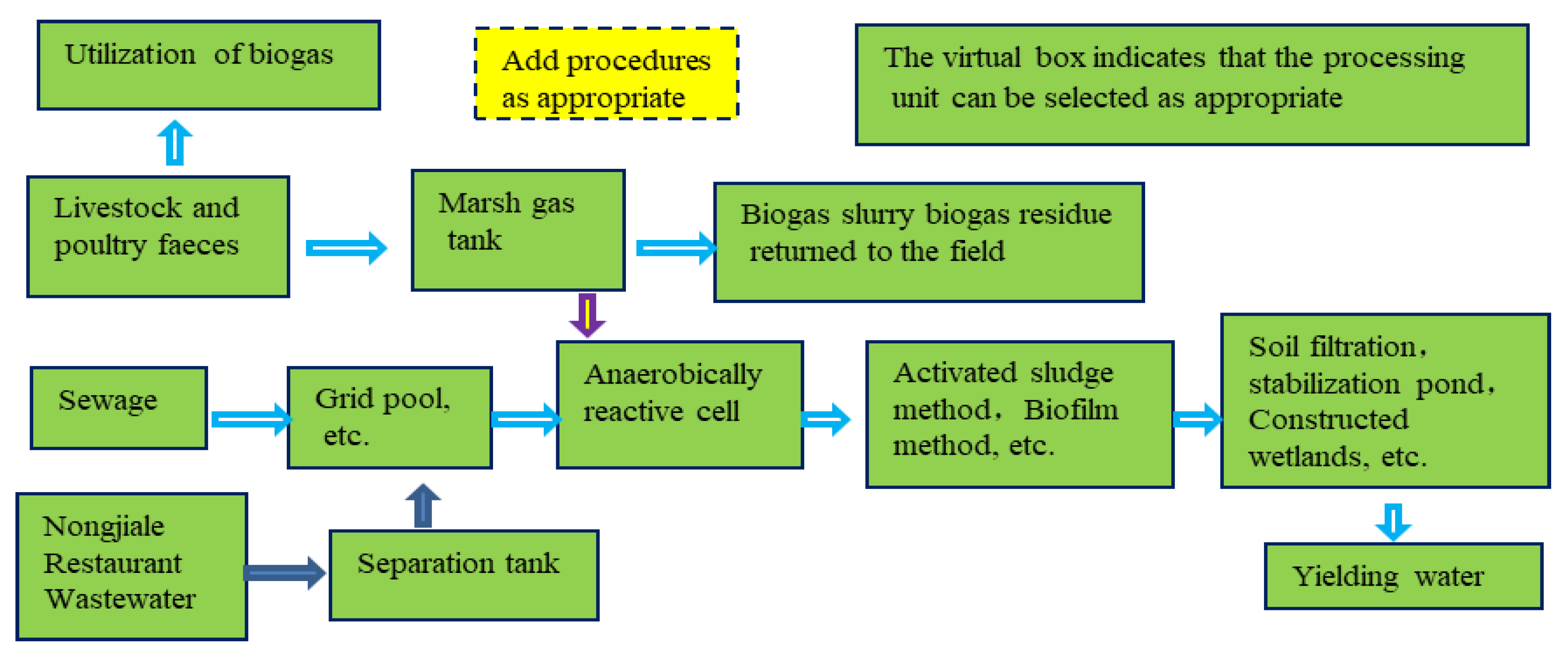

| CODcr | Chemical oxygen demand | BODs | Biochemical oxygen demand |
| SS | Suspended matter | AVO | Animal and vegetable oil |
| NH3-N | Ammonia nitrogen | TN | Total nitrogen |
| TP | Total phosphorus | FCC | Fecal coliform count |
| SDR | Sediment rate | TLPP | Total population |
| UR | Urbanization rate | RCI | Rural per capita disposable income |
| PIT | Proportion of primary industry in the total | Treatment rate of five types of main sewage | |
| Indirect treatment rate of surface sewage | Ratio of sewage treated by simple method | ||
| Comprehensive sewage treatment rate | Farm sewage treatment rate | ||
| Sewage discharge rate up to standard of township enterprises hospitals | Comprehensive sewage treatment rate of rural hospitals | ||
| Domestic sewage treatment rate | Agricultural non-point sewage treatment rate | ||
| Sewage rate reduced by centralized garbage treatment | Sewage rate reduced by agricultural waste recycling | ||
| Sewage rate reduced by transformation of rural toilets farms | Simple sewage treatment of livestock and poultry | ||
| Simple sewage treatment rate of township enterprises | Other simple treatment sewage rate | ||
| Rural domestic sewage treatment rate | Urban domestic sewage treatment rate | ||
| Treatment rate of rural domestic garbage | Urban domestic waste treatment rate | ||
| Recycling rate of agricultural wastes | Rural toilet transformation rate |
| n | 3 | 4 | 5 | 6 | 7 | 8 | 9 |
|---|---|---|---|---|---|---|---|
| RI | 0.58 | 0.90 | 1.12 | 1.24 | 1.32 | 1.40 | 1.45 |
| County Average | Fanchang | Feixi | Wuwei | Dongzhi | Jingxian | Taihe | Zongyang | Linquan | Fenyang | Shouxian | Average |
|---|---|---|---|---|---|---|---|---|---|---|---|
| TTPP (10,000) | 27.96 | 84.69 | 118.62 | 54.6 | 27.6 | 138.0 | 71.9 | 230.7 | 79.23 | 139.92 | |
| UR | 59.86 | 65.4 | 68.31 | 55.6 | 56.33 | 46.2 | 57.0 | 30.46 | 49.91 | 42.9 | |
| RCI (CNY) | 26,357 | 26,062 | 20,282 | 17,394 | 17,001 | 14,582 | 14,628 | 13,723 | 13,837 | 13,177 | |
| PIT | 3.96 | 7.11 | 15.70 | 15.56 | 15.28 | 12.58 | 17.9 | 23.01 | 10.84 | 24.89 | 16.82 |
| 16.21 | 12.2 | 10.1 | 9.8 | 6.5 | 4.6 | 1.9 | 5.8 | 1.8 | 8.7 | 7.06 | |
| 68 | 67.8 | 65 | 62 | 61.5 | 62 | 64 | 60.2 | 60 | 63 | 62.73 | |
| 86 | 86 | 84.2 | 82.4 | 75.2 | 73.2 | 74 | 72.3 | 71.1 | 80.1 | 77.26 | |
| [0.1730] | 80 | 81 | 61 | 56 | 58 | 52 | 51 | 51 | 62 | 65 | 58.87 |
| 98 | 98.3 | 95.06 | 96.03 | 92.12 | 90.25 | 89.3 | 88.36 | 88.32 | 91.2 | 91.59 | |
| [0.2463] | 70 | 88 | 54 | 46 | 49 | 45 | 48 | 56 | 57 | 54.02 | |
| 97.5 | 96.3 | 95.06 | 92.16 | 89.3 | 88.35 | 88.35 | 90.24 | 89.3 | 93.12 | 91.57 | |
| [0.0526] | 71.2 | 78.5 | 42.1 | 42.4 | 27.6 | 22.3 | 15.8 | 36.5 | 18.9 | 27.5 | 35.64 |
| 96.04 | 95.2 | 95 | 93.1 | 96.04 | 92.15 | 91.2 | 96.04 | 90.25 | 91.2 | 93.59 | |
| [0.3217] | 60.98 | 58.85 | 24.51 | 26 | 20.13 | 16.61 | 20 | 12.8 | 15.92 | 25.39 | 23.70 |
| 98.6 | 98.5 | 97.02 | 94.08 | 89.24 | 89.3 | 90.24 | 94.5 | 91.4 | 93.1 | 94.87 | |
| [0.2664] | 6.1 | 6.5 | 5.8 | 5.3 | 4.7 | 5.4 | 5.2 | 4.6 | 4.0 | 4.4 | 5.01 |
| 80 | 81 | 79 | 76 | 73 | 74 | 70 | 73 | 70 | 71 | 74.18 | |
| [0.4884] | 5 | 3 | 8.5 | 12.6 | 18.5 | 21 | 20.8 | 21 | 22 | 21.4 | 17.03 |
| 48 | 50 | 45 | 45 | 43 | 45 | 41 | 44 | 44 | 45 | 44.85 | |
| [0.2935] | 9 | 8.5 | 10 | 15.2 | 15.6 | 20.4 | 20.7 | 24.8 | 25.5 | 28 | 19.91 |
| 55 | 54.3 | 52 | 64 | 62.5 | 53 | 53 | 52.5 | 50.4 | 54 | 52.90 | |
| [0.2181] | 4 | 4.5 | 4.8 | 6.3 | 7.5 | 8 | 11 | 11.5 | 9.6 | 8.4 | 8.32 |
| 35 | 35 | 33 | 30 | 32 | 35 | 32 | 32 | 31.5 | 32 | 32.74 | |
| [0.2740] | 15.05 | 14.82 | 14.22 | 14.21 | 13.50 | 13.61 | 13.66 | 13.72 | 13.11 | 14.55 | 13.98 |
| [0.2181] | 15.2 | 15.3 | 14.4 | 14.59 | 14.26 | 14.45 | 13.71 | 13.58 | 13.98 | 13.76 | 14.14 |
| [0.5079] | 8.38 | 8.84 | 8.6 | 8.33 | 8.0 | 9.0 | 8.66 | 8.83 | 8.28 | 7.2 | 8.48 |
| County Average | Fanchang | Feixi | Wuwei | Dongzhi | Jingxian | Taihe | Zongyang | Linquan | Fenyang | Shouxian | Average |
|---|---|---|---|---|---|---|---|---|---|---|---|
| [0.68615] | 54.61 | 58.63 | 33.65 | 30.76 | 28.11 | 25.70 | 25.20 | 25.09 | 28.11 | 33.07 | 31.49 |
| [0.30573] | 2.93 | 2.43 | 3.74 | 5.59 | 6.75 | 8.40 | 8.15 | 9.14 | 9.16 | 9.73 | 7.47 |
| [0.00812] | 11.70 | 11.89 | 11.40 | 11.31 | 10.87 | 11.45 | 11.13 | 11.21 | 10.85 | 10.64 | 11.22 |
| Tap Water Quality | Groundwater Quality | Rural Small River | Pond, Reservoir | Farmland, Aquaculture Pond | |
|---|---|---|---|---|---|
| Fanchang | (0.920, 0.058, 0.022) | (0.115, 0.436, 0.449) | (0.802, 0.181, 0.013, 0.004) | (0.654, 0.223, 0.120, 0.003) | (0.011, 0.543, 0.332, 0.114) |
| Score (grade) | 98.98 | 76.66 | Surface water (overall) | 60.84 | (IV, 0.543) |
| Feixi | (0.901, 0.067, 0.032) | (0.142, 0.421, 0.437) | (0.805, 0.142, 0.021, 0.032) | (0.584, 0.203, 0.210, 0.003) | (0.045, 0.273, 0.421, 0.261) |
| Score (grade) | 96.386 | 77.05 | Surface water (overall) | 38.42 | (V, 0.421) |
| Wuwei | (0.851, 0.120, 0.029) | (0.065, 0.517, 0.418) | (0.630, 0.213, 0.135, 0.022) | (0.412, 0.136, 0.201, 0.251) | (0.008, 0.113, 0.523, 0.356) |
| Score (grade) | 98.22 | 76.47 | Surface water (overall) | 40.46 | (V, 0.523) |
| Dongzhi | (0.853, 0.105, 0.042) | (0.024, 0.524, 0.452) | (0.541, 0.323, 0.122, 0.014) | (0.332, 0.223, 0.203, 0.242) | (0.001, 0.025, 0.741, 0.233) |
| Score (grade) | 98.11 | 75.72 | Surface water (overall) | 40.46 | (V, 0.523) |
| Jingxian | (0.807, 0.092, 0.101) | (0.015, 0.531, 0.454) | (0.552, 0.341, 0.104, 0.003) | (0.284, 0.291, 0.214, 0.285) | (0.002, 0.030, 0.772, 0.196) |
| Score (grade) | 97.06 | 75.61 | Surface water (overall) | 45.4 | (V, 0.77) |
| Taihe | (0.802, 0.102, 0.096) | (0.025, 0.511, 0.464) | (0.521, 0.324, 0.110, 0.045) | (0.275, 0.301, 0.221, 0.203) | (0.002, 0.028, 0.752, 0.218) |
| Score (grade) | 97.06 | 76.31 | Surface water (overall) | 45.04 | (V, 0.752) |
| Zongyang | (0.604, 0.251, 0.145) | (0.011, 0.541, 0.448) | (0.332, 0.215, 0.212, 0.241) | (0.211, 0.257, 0.242, 0.290) | (0.001, 0.032, 0.688, 0.279) |
| Score (grade) | 94.59 | 75.63 | Surface water (overall) | 43.76 | (V, 0.688) |
| Linquan | (0.781, 0.204, 0.015) | (0.005, 0.522, 0.473) | (0.232, 0.221, 0.242, 0.305) | (0.201, 0.313, 0.106, 0.380) | (0.001, 0.025, 0.691, 0.283) |
| Score (grade) | 97.66 | 75.32 | Surface water (overall) | 42.82 | (V, 0.691) |
| Fengyang | (0.792, 0.204, 0.004) | (0.024, 0.527, 0.449) | (0.701, 0.112, 0.133, 0.054) | (0.310, 0.312, 0.112, 0.266) | (0.002, 0.022, 0.642, 0.334) |
| Score (grade) | 96.98 | 75.75 | Surface water (overall) | 43.84 | (V, 0.642) |
| Shouxian | (0.771, 0.210, 0.019) | (0.017, 0.516, 0.467) | (0.692, 0.231, 0.064, 0.013) | (0.224, 0.323, 0.225, 0.228) | (0.001, 0.019, 0.652, 0.328) |
| Score (grade) | 97.52 | 75.50 | Surface water (overall) | 43.04 | (V, 0.652) |
| 0.61946 | 0.7300 | 0.75336 | 0.83587 | 0.89319 | 0.95267 | 0.92978 | 1.00000 | 0.84577 | 0.76540 | |
| 0.61113 | 0.82243 | 0.67506 | 0.70607 | 0.75900 | 0.89633 | 0.82817 | 0.938103 | 0.95203 | 0.88452 | |
| 0.62115 | 0.70183 | 0.57370 | 0.66869 | 0.55923 | 0.58724 | 0.54063 | 0.75820 | 0.58187 | 0.67968 | |
| 0.54505 | 0.53850 | 0.46950 | 0.53875 | 0.51217 | 0.54704 | 0.56905 | 0.54343 | 0.56050 | 0.6589 | |
| 0.34135 | 0.34633 | 0.40869 | 0.70598 | 0.87598 | 0.85671 | 0.89332 | 0.90336 | 0.86181 | 0.92033 | |
| Correlation Coefficient of | ||||||||||
| 0.64090 | 0.52434 | 0.02078 | 0.06515 | 0.03390 | 0.01458 | 0.20916 | 0.41447 | 0.18448 | 0.35000 | |
| 0.54090 | 0.59434 | 0.09078 | 0.16515 | 0.12390 | 0.01542 | 0.26916 | 0.44447 | 0.12448 | 0.43000 | |
| 0.55290 | 0.49934 | 0.20978 | 0.20115 | 0.33790 | 0.28242 | 0.56116 | 0.55947 | 0.24652 | 0.72500 | |
| 0.45070 | 0.30284 | 0.38568 | 0.36515 | 0.41260 | 0.33932 | 0.51916 | 0.79647 | 0.27632 | 0.74610 | |
| 0.04710 | 0.16566 | 0.52978 | 0.23485 | 0.04390 | 0.13458 | 0.09916 | 0.34447 | 0.17448 | 0.45000 | |
Disclaimer/Publisher’s Note: The statements, opinions and data contained in all publications are solely those of the individual author(s) and contributor(s) and not of MDPI and/or the editor(s). MDPI and/or the editor(s) disclaim responsibility for any injury to people or property resulting from any ideas, methods, instructions or products referred to in the content. |
© 2023 by the authors. Licensee MDPI, Basel, Switzerland. This article is an open access article distributed under the terms and conditions of the Creative Commons Attribution (CC BY) license (https://creativecommons.org/licenses/by/4.0/).
Share and Cite
Xu, W.; Liu, Z. Evaluation on the Current Situation of Integrated Treatment of Rural Sewage in China: A Case Study of Anhui Province. Water 2023, 15, 415. https://doi.org/10.3390/w15030415
Xu W, Liu Z. Evaluation on the Current Situation of Integrated Treatment of Rural Sewage in China: A Case Study of Anhui Province. Water. 2023; 15(3):415. https://doi.org/10.3390/w15030415
Chicago/Turabian StyleXu, Wei, and Zhulin Liu. 2023. "Evaluation on the Current Situation of Integrated Treatment of Rural Sewage in China: A Case Study of Anhui Province" Water 15, no. 3: 415. https://doi.org/10.3390/w15030415
APA StyleXu, W., & Liu, Z. (2023). Evaluation on the Current Situation of Integrated Treatment of Rural Sewage in China: A Case Study of Anhui Province. Water, 15(3), 415. https://doi.org/10.3390/w15030415






